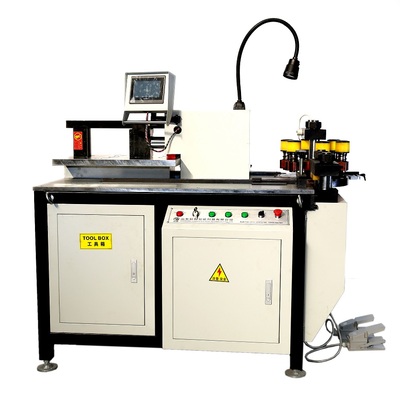Products Description
I. Overview
The CNC busbar processing machine features a numerically controlled bending unit and is equipped with three workstations—punching, shearing, and bending—enabling automated positioning and processing of busbars for operations such as punching, shearing, and bending. By changing molds, it can perform a variety of processes including punching round holes, elongated holes, square holes, flat bending, vertical bending, embossing, flattening, twisting, and pressing terminals. This significantly improves work efficiency, enhances ease of use, and reduces labor intensity.
The three-station CNC busbar processing machine adopts a horizontal processing method for the bending unit, ensuring structural strength and providing more uniform performance during flat bending and embossing. This greatly improves repeat positioning accuracy in mass production and extends the service life. In addition to all the features of standard models, the CNC busbar processing machine also includes the following functions: the bending unit uses numerical control, allowing users to input material thickness and bending angle, with the system automatically performing internal calculations and generating data for bending processing. It precisely controls the stroke via a wire encoder and can also control the operation of the punching and shearing units. Operators can store on-site processing data into the system at any time, with parameter adjustment and compensation functions. The operation display uses a 7-inch touch screen with a color display mode, allowing modification of unsuitable data. If non-standard workpieces are used, operators can also set data for processing according to the requirements of non-standard workpieces, making operation very convenient. It is an ideal equipment for busbar processing.
II. Machine Purpose and Features
This machine is mainly used for processing various specifications of copper and aluminum busbars. Users can perform punching, shearing, and bending of busbars on the corresponding processing units. It offers high production efficiency and is an ideal equipment for the high and low voltage electrical appliance manufacturing industry. The bending workstation is integrally cast from ductile iron, increasing the strength of the bending column. It provides uniform embossing, an integrated worktable, simple and quick mold replacement, and comes with a material stop ruler. The bending unit adopts a dual worktable design, allowing the three units to work simultaneously without interfering with each other, thereby improving processing efficiency.
This machine has the following main features:
1. The machine is equipped with three processing units—punching, shearing, and bending—which can perform punching, shearing, and bending of busbars respectively. Using this machine can significantly improve production efficiency compared to traditional busbar processing equipment, while also significantly enhancing ease of use.
2. The working stroke of each processing unit can be easily adjusted (within the stroke limit range), thereby reducing processing time and improving production efficiency.
3. By changing molds, it can also achieve various processing functions, such as vertical bending, embossing, and reverse flattening.
4. The machine is equipped with both manual buttons and foot switches for operation, making it simple, convenient, and flexible to use. Generally, skilled workers can easily operate it.
III. Technical Parameters
Punching Processing Rapid punching 80 times per minute | Max. Punching Force (KN) | 300 |
Punching Range (mm) | Ø4.3~Ø34 | |
Max. Thickness (mm) | 12 | |
Max. Width (mm) | 160 | |
Shearing Processing | Max. Shearing Force (KN) | 400 |
Max. Thickness (mm) | 12 | |
Max. Width (mm) | 160 | |
Bending Processing | Max. Bending Force (KN) | 300 |
Max. Width (mm) | 160 | |
Max. Thickness (mm) | 12 | |
Overall Dimensions | Millimeter | 1688*1210*1520 |
Worktable Size | Millimeter | 1688*1210*20 |
Second Layer Worktable | Millimeter | 600*660*53 |
Punching Unit Turret Optional Stations: 6 stations | Ductile iron one-time molding ensures absolute alignment | |
Punching, Shearing Unit Dual Columns | Φ50 Optical Axis | |
First Layer Worktable Plate Thickness | 16MM | |
Second Layer Worktable Plate Thickness | 53MM | |
Turntable Diameter | 400MM | |
Turntable Thickness | 47MM | |
Turntable Height | 135MM | |
Table Stop Ruler Length | 1000MM | |
Motor Power | Kilowatt | 3×4KW (Hydraulic Motor) |
Machine Weight | Kilogram | 1250 |
Power Requirement | Voltage/Frequency | 380V/50HZ |
CNC Description | CNC bending angle, Siemens PLC control, direct angle input, accuracy ±1°, repeatability ±0.5°. Punching, shearing, and bending can work simultaneously. It can also input height and side length to directly process the required workpiece (Z-bend with unfolding calculation). Equipped with memory function and copper/aluminum busbar switching function. | |
IV. Machine Structure and Working Principle
This machine consists of a frame, punching unit, shearing unit, bending unit, hydraulic station, electrical system, and molds.
The frame is welded from square steel pipes, providing sufficient strength and rigidity. The punching, shearing, bending units, and electrical components are mounted on the frame, while the hydraulic station is placed inside the frame. The working principle of this machine is as follows:
Motor (provides power to the pump) → Pump (generates high-pressure hydraulic power) → Relief valve (controls pressure) → Solenoid directional valve (directs pressure oil to each cylinder) → Cylinder (cylinder movement achieves punching, shearing, and bending processing).
The motor rotates and transmits power to the oil pump, which generates high-pressure oil. When the solenoid directional valve is not activated, the high-pressure hydraulic oil is directly returned to the oil tank. When the solenoid directional valve is activated, the pressure oil provided by the pump is directed through the directional valve to different working chambers of the cylinder, thereby enabling the cylinder to perform reciprocating motion.
Product Photos



